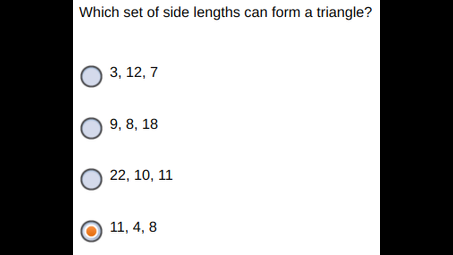What else can I help you with?
Which set of side lengths cannot form a triangle?
1.5m
Which set of side lengths will not form a right triangle?
Plug the side lengths into the Pythagorean theorem in place of a and b. If a2 + b2 = c2, it's a right triangle. C needs to be an integer, so c2 will be a perfect square.
Which set of numbers represent the side lengths of an obtuse triangle?
Those ones, there!
Which set of values could be the side lenghts of a 30 60 90 triangle?
There cannot be an integral set of values. The lengths need to be in the ratio 1 : sqrt(3) : 2.
Which shape has 1 set of parallel lines?
It is a trapezoid that has one set of opposite parallel lines of different lengths.
Which set of side lengths cannot form a triangle?
1.5m
What is the sum of the lengths of any two sides of a triangle is greater than the length of the third side?
The statement that the sum of the lengths of any two sides of a triangle is greater than the length of the third side is known as the Triangle Inequality Theorem. This theorem is fundamental in geometry and ensures that a set of three lengths can form a triangle. If this condition is violated, the three lengths cannot connect to form a triangle. Essentially, it guarantees the triangle's stability and shape.
Which set of side lengths will not form a right triangle?
Plug the side lengths into the Pythagorean theorem in place of a and b. If a2 + b2 = c2, it's a right triangle. C needs to be an integer, so c2 will be a perfect square.
How do you know if you can make more that one triangle?
To determine if you can make more than one triangle with a given set of side lengths, you can use the triangle inequality theorem, which states that the sum of the lengths of any two sides must be greater than the length of the remaining side. If the side lengths meet this condition, you can form a triangle, but if the side lengths are the same (like in the case of an equilateral triangle), only one unique triangle can be formed. Additionally, if the angles are not specified and the side lengths allow for different arrangements, multiple triangles may be possible.
Which set of numbers represent the side lengths of an obtuse triangle?
Those ones, there!
Can the set of lengths be the side lengths of a right triangle 7ft 12ft 17ft?
No because the given sides do not comply with Pythagoras' theorem for a right angle triangle.
How many examples are in a triangle shapes set?
Infinitely many. The smallest side of a triangle can have infinitely many possible lengths.
Which set of 3 numbers could be the side lengths of a triangle apex?
To determine if three numbers can be the side lengths of a triangle, they must satisfy the triangle inequality theorem, which states that the sum of the lengths of any two sides must be greater than the length of the remaining side. For example, the set of numbers 3, 4, and 5 satisfies this criterion, as 3 + 4 > 5, 3 + 5 > 4, and 4 + 5 > 3. Thus, 3, 4, and 5 could be the side lengths of a triangle.
What three set of numbers could make a triangle?
To form a triangle, the lengths of its sides must satisfy the triangle inequality theorem, which states that the sum of the lengths of any two sides must be greater than the length of the third side. For example, the sets of numbers (3, 4, 5), (5, 7, 10), and (6, 8, 10) can all form triangles. In each case, the sum of the lengths of any two sides is greater than the length of the third side.
What set of numbers could represent the lengths of a side of a triangle?
To represent the lengths of the sides of a triangle, the numbers must satisfy the triangle inequality theorem. This means that the sum of the lengths of any two sides must be greater than the length of the third side. For example, the set of numbers 3, 4, and 5 can represent the sides of a triangle because 3 + 4 > 5, 3 + 5 > 4, and 4 + 5 > 3.
Antonio cuts pieces of string to diffrent lenghts. select all of the sets of string lenghts that form a right triangle.?
To determine which sets of string lengths form a right triangle, you can use the Pythagorean theorem, which states that for three lengths (a), (b), and (c) (where (c) is the longest side), the equation (a^2 + b^2 = c^2) must hold true. You can check each set of lengths by squaring the two shorter lengths and seeing if their sum equals the square of the longest length. Any set that satisfies this condition forms a right triangle.
What set of lengths can be used to make a triangle?
There are many lengths that can be used to make triangles. Basically take the longest side, add the two shorter sides together, it can be a triangle as long as the 2 shorter sides added together are longer than the longest side.

